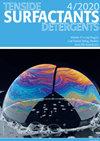异丙醇对蠕虫状胶束流变行为的影响
IF 1.2
4区 工程技术
Q4 CHEMISTRY, APPLIED
引用次数: 0
摘要
研究了用异丙醇(IP)代替水对在25 ℃下由十六烷基三甲基溴化铵(CTAB)和水杨酸钠(鼻)混合制备的蠕虫状胶束水溶液(WLMs)流变性能的影响。CTAB水溶液的粘度随鼻腔的增加呈现两个最大值和一个最小值,鼻腔由纠缠的wlm组成。当用增加的IP量代替水时,粘度最大值和最小值发生了急剧变化。随着IP含量的增加(高达5 wt%),这些溶液的弹性平台模量G°几乎保持不变,而它们的弛豫时间则急剧变化。CTAB的临界胶束浓度(CMC)随着IP的增加而增加,表明胶束亲水性增加。对于最小粘度的WLMs,在最大和最小粘度的WLMs中增加IP(>5.0 %),导致弹性模量G°急剧下降,表明形成了更小的胶束聚集体。在相同的NaSal/CTAB粘弹性体系中,还比较了IP作为助溶剂对WLMs流变性能的影响,并与甘油和1,3丁二醇(1,3 BD)进行了比较。本文章由计算机程序翻译,如有差异,请以英文原文为准。
Influence of isopropanol on the rheological behavior of wormlike micelles
Abstract The influence of replacing water with isopropanol (IP) on the rheological properties of aqueous solutions containing wormlike micelles (WLMs) prepared by mixing cetyltrimethylammonium bromide (CTAB) and sodium salicylate (NaSal) at 25 °C was investigated. Viscosity of CTAB aqueous solutions exhibits two maxima and one minimum with increasing amounts of NaSal, consisting of entangled WLMs. When water is replaced by increasing amount of IP, the viscosity maxima and the minimum changes drastically. The elastic plateau modulus G° of these solutions remains almost the same with increasing IP contents (up to ∼5 wt%), whereas their relaxation time changes drastically. Critical micelle concentration (CMC) of CTAB has increased with further IP addition, indicating an increase in the micellar hydrophilicity. For WLMs at minimum viscosity, increasing addition of IP (>5.0 %) to WLMs at maximum and minimum viscosities, leads to a drastic decrease in the elastic modulus G°, indicating the formation of smaller micellar aggregates. The influence of IP as a co-solvent on the WLMs rheological properties is also compared to that of glycerol and 1,3 butanediol (1,3 BD) for the same NaSal/CTAB viscoelastic system.
求助全文
通过发布文献求助,成功后即可免费获取论文全文。
去求助
来源期刊

Tenside Surfactants Detergents
工程技术-工程:化工
CiteScore
1.90
自引率
10.00%
发文量
57
审稿时长
3.8 months
期刊介绍:
Tenside Surfactants Detergents offers the most recent results of research and development in all fields of surfactant chemistry, such as: synthesis, analysis, physicochemical properties, new types of surfactants, progress in production processes, application-related problems and environmental behavior. Since 1964 Tenside Surfactants Detergents offers strictly peer-reviewed, high-quality articles by renowned specialists around the world.
 求助内容:
求助内容: 应助结果提醒方式:
应助结果提醒方式:


